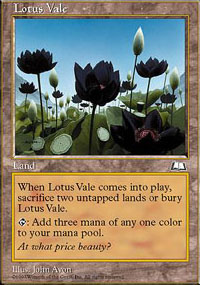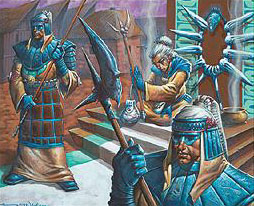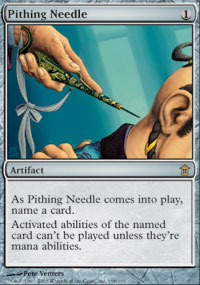
(Due to the timeliness of this article, MTGCast has agreed to slip back a day. Your regularly scheduled 'Cast will be up Tuesday evening with a very special edition!)
In a recent article I took a look at the philosophy which I believe should be used to issue errata. Recently, Mark Gottlieb informed us of the errata changes that were to be implemented when Tenth Edition became live on Oracle. I applaud Mr. Gottlieb for his decision to inform us of the changes ahead of time (although “ahead of time” is only two days), which is a change in policy from the past. However, what did Mr. Gottlieb decide to change and why did he change it? Were these changes desirable?
If you haven’t read Mr. Gottlieb’s article I suggest that you do so now so you will be able to follow along with me, as I will be assuming that you have read the article. Additionally, I will be addressing the cards in the order that he does for simplicity.
The first card, and definitely the biggest change, comes with Phyrexian Dreadnought. Looking at the text of the card, this would seem to be a step in the right direction. Interestingly, in a previous article, Wizards stated:

You can’t help but wonder what fate
awaits Lotus Vale and friends.
Lotus Vale / Mox Diamond / Phyrexian Dreadnought – More cards that had their functionality disrupted by a rules change. The intent of these cards was always that the costs had to be paid before the cards could be used, and we want to maintain that.
Apparently Wizards is having a change of heart about errata, even today. Perhaps this foreshadows more changes in the future. In any case, people who follow errata (Pathetic, isn’t it? The Oracle’s Attendants are out there though, trust me.) will be quick to point out that Lotus Vale, Scorched Ruins, and Mox Diamond appear to have been left out in the cold, again. I would speculate that errataing either of these cards would have some sort of impact on the Eternal formats, Legacy and Vintage. For those unaware of the trick, after the permanent comes into play, the mana ability can be played before the sacrifice trigger resolves, essentially bypassing the entire drawback (although the land will still be sacrificed). I will admit that I do not know a whole lot about Legacy, but somehow I think the impact would be greater there than in Vintage, especially if these cards were allowed to run around unbanned for a while (anybody remember a card called Flash?). Consequently, I would see these getting banned in Legacy. Regarding Vintage, a restriction would be probable. Sure, you might use your land drop up by playing Lotus Vale or Scorched Ruins, but if you could run them as a four-of, you would effectively be getting a black lotus with a fairly high probability on your first turn. This would become degenerative fairly quickly. Indeed, even I, a strong advocate against this sort of errata, am somewhat afraid of the changes that might occur. However, that’s what the cards say. Therefore, the question is: why were Lotus Vale, Scorched Ruins, and Mox Diamond excluded? Only Mr. Gottlieb can answer that. It is worth noting (if my memory serves me correctly) that errata was issued very shortly after the set was released (whether it was emergency errata or not, I do not know) in order to prevent exactly such an abuse. Perhaps Mr. Gottlieb thinks that if errata is issued so close to the time of release that it should be allowed to stick. Your guess is as good as mine.I subtly mentioned above the fact that the Oracle updates and the Banned/Restricted updates do not occur on the same timetable. Legacy players are acutely aware of this after Flash ran amok, at a major event no less. What if Lotus Vale had been reverted to its old wording? Should Legacy again be subjected to the abuse implicit in this policy? The answer is clearly “no.” Wizards needs to make some sort of effort to close this loophole. Mr. Gottlieb’s explanation is:

The Oracle’s Attendants are ever vigilant,
especially during an update.
The release of each new Magic set comes packaged with two updates to the Magic infrastructure: an update to the Comprehensive Rules, and an update to the Oracle card database. This coincides with set releases for a simple reason: The new cards cause us to change these things anyway! The new cards (or, in the case of a Core Set, the updated cards) are incorporated into Oracle, and the Comp Rules get revised to handle new keywords, new card types, new bizarre cards, and so on. As long as we're monkeying with Oracle and the Comp Rules for new business, we might as well take care of some old business at the same time.
While I can certainly see the technical value in this, there needs to be mechanisms in place to handle these problems. Essentially, I see two ways this could be done: either issue some extra errata when the B/R comes out or issue extra B/R when the new errata comes out. Both of these solutions have their subtleties and problems, but I would say they are both strictly better than the current situation.Next is Natural Selection. I have always thought this card was kind of interesting in that it is a weaker (and green) predecessor to Brainstorm. The issue here is the addition of the word “target” to the template, which would change the current functionality of the card because it currently cannot be Misdirected, among other things. A quick search of Alpha informed me that the word “target” does actually appear on alpha cards, such as Death Ward, so the argument that “target” came into being after Alpha cannot be used.
This situation, admittedly, is difficult. The word “target”, since the time of Alpha, has come to have a significant meaning beyond the casual language that was used in Alpha to describe what cards do. “Target” nowadays is used in contrast to “choose”, such as on a card like Sundering Titan. Another subtlety of the language (beyond the Misdirection issue) is that the entities affected are selected on resolution rather than on announcement if “choose” is used, something that can matter quite a bit sometimes. Mr. Gottlieb correctly points to Ancestral Recall (aside: mine is in the mail, I’m so excited) as a card comparable to Natural Selection. Ancestral Recall also does not have the word “target” on it, but has had “target” in its Oracle text for some time. Consequently, Misdirection sees some play in Vintage. Because the word “target” was not nearly as sacred in Alpha as it is now, adding “target” to the card cannot indisputably be considered a functional change, and therefore, I cannot say that it is unjustified. I do applaud the reasoning of making this card sync up with others in the set, such as Ancestral Recall. A uniform policy regarding this sort of language is important with respect to having a logical errata policy.

Eron can use Fire Whip the turn he
comes into play like he is supposed
to, but for the wrong reasons.
The Ice Age depletion lands had previously been errataed to simply not untap during its controller’s next untap step. Functionality was restored by adding the counters again. Because this is a reversion to original text, this change is justified. Well done.
I am so delighted that Mr. Gottlieb decided to bring up cards like Imagecrafter because I think it brings up an important issue with respect to the Legend change. When Legends were first printed (in the set Legends, what an amazing coincidence), lands, like Tolaria, were given the Legendary supertype (I don’t know if supertype was the technical term then, but that is effectively what it was) while creatures, like Tor Wauki were given the Legend subtype. This discontinuity persisted for a while until Wizards finally decided that it made more sense for creatures with the Legend subtype to be referred to as Legendary creatures, something that makes sense, especially considering that other permanents other than lands have since been allowed to have the Legendary supertype. What this did, however, was create a functional change for some cards that has not been addressed. The grossest example of this change is Karona, False God. Being able to choose “Legendary Creatures” is crucial to the functionality of this card. Why? Because as it stands now, Karona cannot give the bonus to itself because it does not have a subtype, something that is very important when the creature is switching sides every turn and something that was able to be done when the card was originally printed. I would suggest something like “Choose a creature type or legendary creatures” as an appropriate template for such cards. Regarding the changes that Mr. Gottlieb has brought up, they are fine because, as Mr. Gottlieb points out, “legend” couldn’t be chosen before (because the card specifically said so) and it can’t be chosen now because it is no longer a valid subtype. Therefore, while I affirm these changes, I would remark that other cards may be in need of changes due to the changing of the Legend Rule.

The word “source” does not appear
anywhere on Pithing Needle.
Pithing Needle is getting a new template in Tenth Edition that's both shorter and more comprehensive. (Yes, we're geniuses.) Voidstone Gargoyle has much the same ability, so it's getting updated to the same wording. This does involve a functional change, but the only time it's relevant is if someone wants to play the activated ability of a copy of Lightning Storm on the stack, and Lightning Storm is the named card. (After the update, you won't be able to play the ability.)
The actual text of Pithing Needle now reads:As Pithing Needle comes into play, name a card.
Activated abilities of sources with the chosen name can’t be played unless they’re mana abilities.
Mr. Gottlieb openly admitted that this is a functional change. For reasons that I elaborated upon at length in my previous article, I strongly oppose this change, as the card was printed very recently (relative to other cards I have discussed) and this therefore leaves very little doubt as to what the card is supposed to do. The card says what it says. The rules can handle it. Let it be.Activated abilities of sources with the chosen name can’t be played unless they’re mana abilities.
Norritt is a card that I pulled in my very first pack of Magic cards, so I have a slight history with it. The errata is justified because previously Norritt’s ability “[c]annot target creatures brought under their controller’s control this turn.” Bonus ultra secret strategy tip: interestingly, nothing was mentioned about the Defender keyword, so Norritt can continue to have a field day with new creatures that do not have the Wall subtype. You had better start naming “black” for Order of the Stars!

He looks pretty angry to me.
While this article is not about the changes to the comprehensive rules (although I am very glad that the issues regarding Leyline of the Void and such have been addressed), it is worth mentioning the change that affects Shahrazad, as the change in the rules effectively equals errata for the card. For reasons unknown to me, cards placed in the removed-from-game zone were treated differently from cards ultimately ending up in any other zone in the subgame. While the removed-from-game zone may have previously resembled the absolutely-removed-from-the-freaking-game-forever zone, that is no longer the case due to the advent of the wishes. I think this mentality was applied to Shahrazad at some point and just stuck. Consider the first few lines of Shahrazad:
Players must leave game in progress as it is and use the cards left in their libraries as decks with which to play a subgame of Magic. When subgame is over, players shuffle these cards, return them to libraries, and resume game in progress… (emphasis added)
The language “these cards” cannot possibly refer to anything except the cards in the players’ libraries when Shahrazad resolved. Shahrazad doesn’t care where that card is now. Consequently, this change was justified. That being said, I am left wondering how the subgame will handle wishes with respect to the cards they grab. I would suggest that the main game be returned to as it previously was, regardless of what the wishes have done to it (barring, of course, the “shuffle your library” effect that is created by Shahrazad at the end of the subgame). Perhaps this issue will be fleshed out in the future.
Some of the changes that have been implemented are good changes, something that we all should be glad to see. However, there are still some discrepancies which need to be addressed. I applaud Mr. Gottlieb for taking a step in the right direction with Phyrexian Dreadnought, but I must also admonish him for the change to Pithing Needle. These two changes being made in the same announcement creates a logical paradox that cannot be explained. In one respect Mr. Gottlieb is going back to the printed word while in another he is intentionally deviating from the printed text. The importance of not allowing reprints to justify errata comes shining through in this example; this event will continue to repeat itself until this policy is changed. Frankly, I find Mr. Gottlieb’s statement that “The nice thing about being the Magic Rules Manager is that my opinions have a funny way of becoming the truth” to be much more than a subtle hint that his opinions will continue to dictate what a printed card says or “should have” said. The players simply cannot find this acceptable, Mr. Gottlieb.
Comments